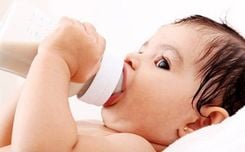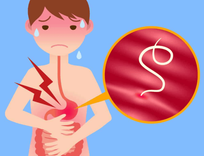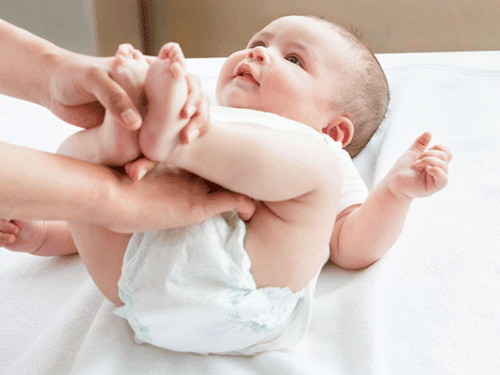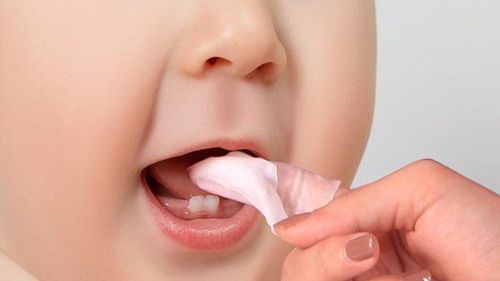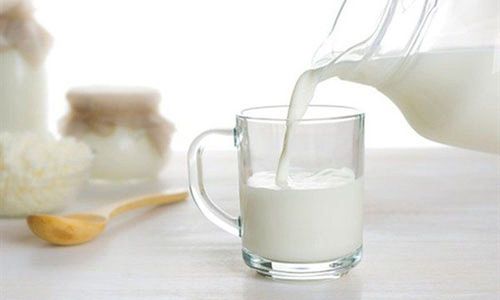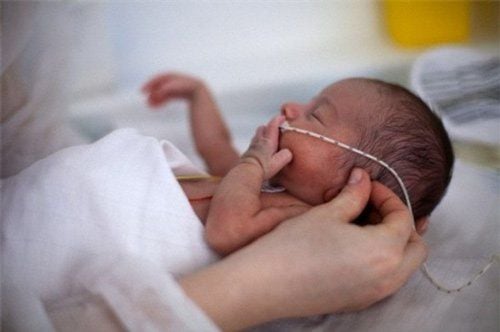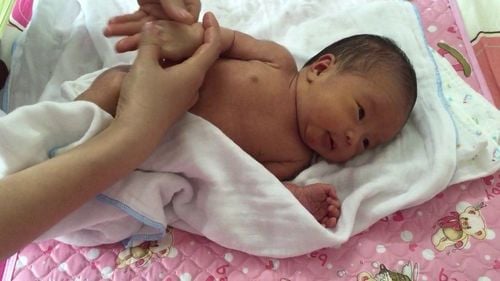The bilirubin index in the blood of newborns is the basis for assessing the level of jaundice in children. Combining the high bilirubin index in newborns with age, health status, and clinical manifestations, the doctor will prescribe appropriate treatment. Let's learn about the causes and consequences when the bilirubin index in the blood of newborns increases through the article below.
1. What is the bilirubin index in the blood of newborns?
In the body, when red blood cells are degraded and broken down, the hemoglobin in the red blood cells will break down into bilirubin, a yellow pigment and excreted through the intestines. Unlike adults, newborns have a high number of red blood cells and they are constantly broken down and replaced. However, the liver in newborns is not yet fully developed, and the intestinal bacterial system is still weak, causing bilirubin to not be excreted, but reabsorbed into the circulatory system, causing jaundice.
The bilirubin index in the blood of newborns is an index that indicates the concentration of bilirubin and shows the level of jaundice in children. Normal bilirubin levels index are defined as follows:
- Total bilirubin: Below 10 mg/dl or 171 μmol/L in newborns and from 0.3 - 1.2 mg/dl or 5.1 - 20.5 μmol/L in children over 1 month old.
- Direct bilirubin: From 0 - 0.4 mg/dl or 0 - 7 μmol/L.
- Indirect bilirubin: From 0.1 - 1.0 mg/dL or 1 - 17 μmol/L.
- Direct bilirubin/total bilirubin ratio: Below 20%.
Bilirubin levels in newborns are usually high in the first few days after birth and gradually decrease in the following days. When testing bilirubin to check the level of jaundice in the baby, depending on the age and risk of disease, the doctor will give a treatment regimen appropriate to the bilirubin level.
2. Causes of high bilirubin in newborns
Causes of high bilirubin in newborns include:
- Physiological: Jaundice in newborns is a transient phenomenon, commonly found in both sick premature babies and healthy full-term babies. The newborn's body continuously produces red blood cells and bilirubin, combined with low clearance and bacteria concentration, causing high bilirubin concentration. At that time, the total bilirubin concentration in the blood can increase to 18 mg/dl when the baby is 3 - 4 days old. But after that, this concentration will gradually decrease, the baby will no longer have jaundice without treatment.
- Pathological: High bilirubin in newborns due to pathological causes is determined when the baby has jaundice in the first 24 hours after birth and lasts more than 2 weeks. Blood tests showed a total bilirubin level higher than 18 mg/dL and an increase in bilirubin in the blood of up to 5 mg/dL per day. The baby's jaundice was also more severe, with jaundice all over the body, yellow eyes, accompanied by refusal to feed, fatigue, and frequent crying. The diseases that cause this condition are known as neonatal hepatitis, cholestasis, and neonatal sepsis.
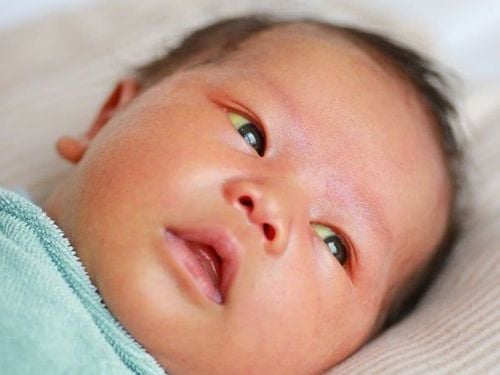
3. Consequences of high bilirubin levels in newborns' blood
Depending on the cause of increased bilirubin in the blood, the consequences may or may not be harmful. In some cases, regardless of the bilirubin concentration, spontaneous jaundice in newborns is still very dangerous. And when the bilirubin index in the newborn's blood increases to a certain level, it will be assessed as causing danger. This threshold depends on the age, the level of premature birth and the health status of the child, specifically:
- Full-term and healthy newborns: When the bilirubin index in the blood is higher than 18 mg/dL, equivalent to 308 μmol/L.
- Premature babies, children with blood infection, low body temperature, hypoxia: No level of increased bilirubin is considered safe, the higher the bilirubin concentration, the higher the risk of toxicity.
Consequences of increased bilirubin index in the blood of newborns include:
- Neurotoxicity: This is the main consequence of increased bilirubin in the blood of newborns and leads to acute encephalitis, cerebral palsy, impaired motor function, and poor cognition.
- Kernel jaundice: This is the most serious consequence but is very rare and can be prevented. Kernicterus is a condition in which bilirubin is deposited in the nucleus and basal ganglia of the brainstem and attacks the blood-brain barrier.
4. Treatment for high bilirubin in newborns
For physiological hyperbilirubinemia, the baby only needs to be closely monitored without treatment, the jaundice will disappear by itself when the baby is 2 weeks after birth, when the baby's liver is fully developed and the baby is fully breastfed. However, jaundice in newborns needs to be treated when the bilirubin concentration is too high, to avoid complications in the brain due to bilirubin attacking the brain and causing damage. In premature babies and babies with poor health with high bilirubin, treatment is based on the age and clinical manifestations of the baby. Currently, the treatment of high bilirubin in newborns includes 2 main methods: phototherapy and blood transfusion.
4.1 Phototherapy
Phototherapy (also known as phototherapy) is a method that uses a special type of lamp with blue light and a wavelength of 400 - 500nm, the peak corresponding to the bilirubin absorption peak has a wavelength of 450 - 460nm. The light from the lamp will penetrate the skin and decompose indirect bilirubin molecules in the fat layer below the skin, then they are eliminated by the liver and kidneys.
In children diagnosed with pathological jaundice due to increased indirect bilirubin, the child is prescribed phototherapy after the first 24 hours when there are no signs of neurotoxicity. Phototherapy is indicated for prophylactic treatment when bilirubin levels are high in newborns with hemolytic disease, large skulls, seromas, and premature infants, specifically:
- Premature infants from 35 weeks of gestation: Phototherapy is indicated when bilirubin is higher than 12 mg/dL (equivalent to 205.2 μmol/L). Phototherapy can be performed within 25-48 hours after birth when bilirubin is higher than 15 mg/dL, within 49-72 hours when bilirubin is 18 mg/dL, and over 72 hours when bilirubin is 20 mg/dL.
- Premature infants under 35 weeks of gestation: The bilirubin threshold for treatment is prescribed to be lower than that of infants from 35 weeks of gestation because they are at higher risk of toxicity.
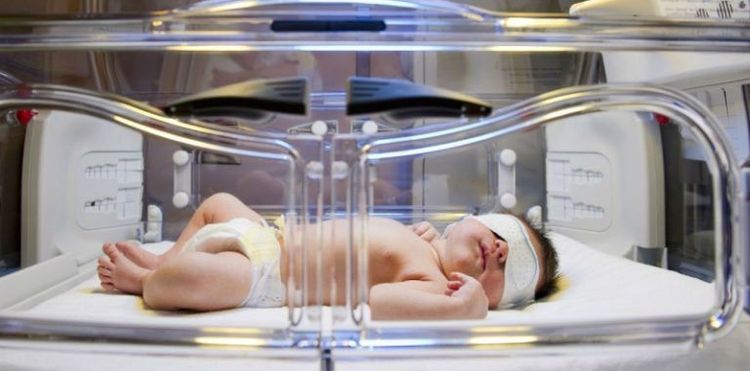
Note, when the bilirubin level in the newborn's blood is high, the baby's clothes must be removed, but the eyes and genitals must be covered. The baby is turned frequently to increase exposure to light, intermittent or continuous.
In full-term and healthy babies, after 3 hours of phototherapy, the baby can be taken out to change diapers or breastfeed. Phototherapy is the main treatment for newborns with jaundice due to high bilirubin levels in the blood, because most babies respond well.
4.2 Blood transfusion
Blood transfusion is a treatment for jaundice due to high bilirubin levels in newborns, allowing rapid removal of bilirubin, indicated in cases where the bilirubin concentration in the blood is too high, endangering the baby's health (often seen in babies with immune hemolytic anemia). This technique involves taking a small amount of the baby's blood and replacing it with another amount of blood.
Blood transfusion indications for high bilirubin levels in full-term newborns are as follows:
- When bilirubin ≥ 20 mg/dL in 24 - 48 hours.
- When bilirubin ≥ 25 mg/dL after 48 hours.
- The baby has been exposed to phototherapy but it is not effective. Immediately after birth, if the bilirubin is higher than 25 mg/dL in the initial examination, it is necessary to be prepared for a blood transfusion in case phototherapy does not reduce bilirubin.
For premature babies, the bilirubin threshold for blood transfusion is different depending on the age.
Depending on the cause of the high bilirubin level in the newborn's blood, the doctor will assess whether it is dangerous or not and prescribe appropriate treatment to reduce bilirubin levels.
The Department of Pediatrics - Vinmec International General Hospital is the address to receive and examine diseases that newborns are susceptible to, including jaundice. At Vinmec, we are equipped with a safe and easy-to-use phototherapy system. Babies can still breastfeed when exposed to phototherapy, and can be combined with 10% Glucose infusion. In addition, at Vinmec, there are many types of phototherapy suitable for each jaundice subject that needs phototherapy: Cradle-shaped light (the baby lies directly on top), double-shaped light that shines above and below (used in cases that require active phototherapy), blanket-shaped light, bag wrapped around the baby (very convenient for mothers when taking care of the baby: can be picked up to breastfeed while using the light).
If the treatment of severe jaundice when using phototherapy is not effective or the baby has severe jaundice late, with a very high concentration of bilirubin in the blood, the doctor will prescribe blood exchange as the last resort. When exchanging blood, we can quickly remove bilirubin circulating in the blood vessels, leading to a decrease in bilirubin in the blood and thereby also reducing bilirubin outside the tissue.
To arrange an appointment, please call HOTLINE or make your reservation directly HERE. You may also download the MyVinmec app to schedule appointments faster and manage your reservations more conveniently.

